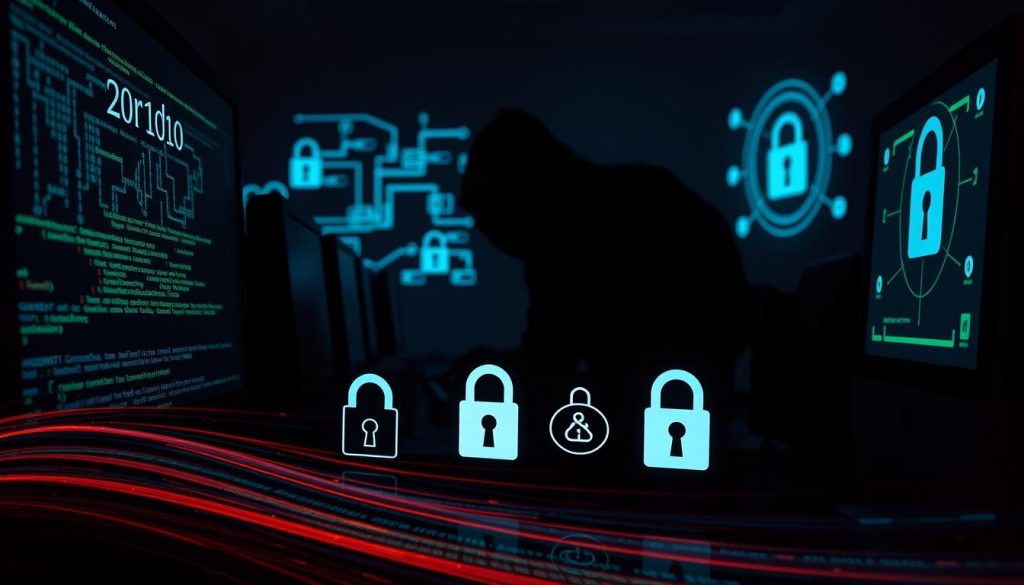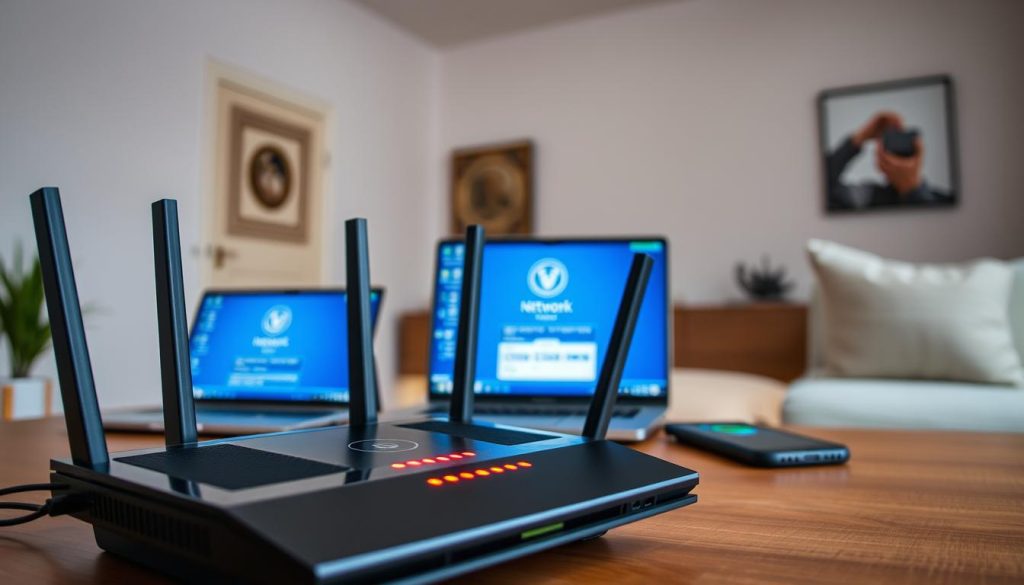As a home user, you might not know about the dangers of zero-day vulnerabilities in your network. Many people face cyber threats because their software is outdated and they don’t follow good security habits.
It’s important to know about these risks to keep your network safe. Zero-day vulnerabilities are new, unknown weaknesses in software that hackers can use. To protect your network, you need to keep up with the latest security news and follow the best home user security practices.
Key Takeaways
- Understand what zero-day vulnerabilities are and their impact on home networks.
- Learn the importance of keeping your software up-to-date to prevent exploitation.
- Discover best practices for securing your home network.
- Find out why monitoring your network for suspicious activity is crucial.
- Stay informed about the latest security updates and alerts.
Understanding Zero-Day Vulnerabilities
It’s key to know about zero-day vulnerabilities to keep your digital world safe. In today’s world, cybersecurity is complex. It’s vital to understand these threats and how they affect your data and safety.
Definition of Zero-Day Vulnerabilities
A zero-day vulnerability is a hidden flaw in software that attackers can use before a fix is found. This flaw is unknown to both the software maker and the public. It’s hard to defend against because it’s not known.
These vulnerabilities can be in many types of software, like operating systems and apps. Attackers can use them to get into your system, steal data, or mess with your service.
How Zero-Day Vulnerabilities Work
Zero-day vulnerabilities let attackers use a flaw that’s not known yet. They can run harmful code, get to your data, or control your system.
First, the attacker finds the flaw. Then, they make an exploit to attack systems. Since it’s unknown, systems are at risk until a fix is found and applied.
Why They Are a Serious Threat
Zero-day vulnerabilities are a big risk for home users. They can be used without warning, leaving your system open to attack. Without a fix, you’re at risk until the problem is solved.
To stay safe, follow good cybersecurity habits. Change default passwords, use strong passwords, and keep your software updated. Regularly update your router password and follow login credential best practices to lower your risk.
| Best Practice | Description | Benefit |
|---|---|---|
| Change Default Passwords | Modify default passwords for devices and applications | Prevents unauthorized access |
| Use Strong Login Credentials | Employ complex and unique passwords for accounts | Enhances security against brute-force attacks |
| Regular Software Updates | Keep software and systems up to date with the latest patches | Fixes known vulnerabilities and protects against exploits |
By understanding zero-day vulnerabilities and taking steps to secure your digital space, you can lower your risk. This makes your digital world safer.
Common Types of Zero-Day Vulnerabilities
To keep your digital life safe, it’s key to know about zero-day vulnerabilities. They fall into three main types: software exploits, hardware exploits, and web application vulnerabilities. Knowing these can help you protect your devices and data better.
Software Exploits
Software exploits find weaknesses in software apps, letting attackers run bad code. This can cause unauthorized access, data loss, or system damage. For example, a zero-day exploit in a popular app can be very risky since it might be used before a fix is found.
- Buffer overflow attacks
- SQL injection
- Cross-site scripting (XSS)
Protecting against software exploits means keeping your software current. Newer versions often fix known issues. Also, using security software to block exploit attempts is helpful.

Hardware Exploits
Hardware exploits find weaknesses in hardware like CPUs, GPUs, or network devices. These are hard to fix since they might need new hardware or firmware updates. For example, a router’s firmware flaw can let an attacker control the network.
Strengthening router security is key to stop hardware exploits. Update your router’s firmware often, change default passwords, and set up your router’s firewall right.
Web Application Vulnerabilities
Web application vulnerabilities happen when web apps aren’t secure. This lets attackers inject bad code or steal data. Common issues include SQL injection and cross-site scripting (XSS). These can cause data breaches, financial loss, and harm to your reputation.
To protect your web applications, use secure coding, update and patch your apps regularly, and use web application firewalls (WAFs) to block attacks.
The Impact of Zero-Day Vulnerabilities on Home Users
Understanding zero-day vulnerabilities is key for home users. These threats can harm personal data and system security. They can affect many parts of our digital lives.

Personal Data Theft
Personal data theft is a big risk with zero-day vulnerabilities. Hackers can get into our systems and steal sensitive info. This includes login details, financial data, and personal documents.
This stolen data can be used for bad things like identity theft and fraud.
Financial Loss
Zero-day vulnerabilities can also cause financial loss for home users. Hackers might use stolen financial info for bad transactions or sell it online. Plus, fixing a zero-day attack can cost a lot.
System Compromise
A zero-day attack can make a home user’s system vulnerable. It might turn into a botnet node or help with bad activities. This can slow down your system and spread malware.
To fight these risks, home users should focus on improving network security and using strong router passwords. Keeping software up to date, using antivirus, and setting up firewalls are important steps.
By being proactive, home users can lessen the harm from zero-day vulnerabilities. They can protect their personal data, financial security, and system integrity.
Recognizing Signs of Zero-Day Attacks
It’s key to know the signs of a zero-day attack to keep your home network safe. These attacks can show up in many ways. So, it’s important to watch your systems closely.
Unusual System Behavior
Unusual system behavior is a big warning sign. This might include slow performance, freezing, or unexpected reboots. If your device acts strangely, it could be under attack.
Watch how your system performs over time. Sudden changes could mean trouble. For example, if your device starts up slowly or apps launch slowly, it might be infected.
Unexpected Software Crashes
Unexpected software crashes are a big warning. If your apps or operating system crash a lot, it might be a zero-day exploit. Look at any error messages they give you. They can tell you a lot about the problem.
Crashes can mess up your work and might even cause you to lose data. So, it’s important to find out why they happen fast.
New or Unknown Applications
Seeing new or unknown applications on your device is a big worry. Malware from zero-day attacks can install unwanted software. Be careful of any apps you don’t know, and check where they came from.
To keep your network safe, make sure your router’s firmware is current. Also, change the default admin password to a strong one. Use WPA3 encryption if you can.

Knowing these signs and taking steps to prevent them can make your home network safer. Always check your systems and keep your software updated. This helps keep your digital world safe.
Best Practices for Protecting Against Zero-Day Vulnerabilities
To keep your digital life safe, it’s key to follow best practices against zero-day threats. Being proactive and informed can greatly lower your risk of falling prey to these dangers.
Regular Software Updates
Keeping your software current is a top way to fight zero-day threats. Updates often patch new vulnerabilities, making them harder for hackers to use. Make sure your operating system, browser, and key software update automatically.
Enable automatic updates for your OS and apps to get the latest security fixes. Check for updates for software that doesn’t auto-update.
Use of Antivirus Software
Antivirus software is vital in catching and blocking malware that could use zero-day vulnerabilities. Pick a trusted antivirus with real-time protection and regular updates.
- Install antivirus software from a trusted vendor.
- Make sure the antivirus updates automatically.
- Scan your system for malware regularly.
Firewall Configuration
A well-set-up firewall blocks unauthorized access, lowering zero-day exploit risks. Ensure your firewall is on and blocks unwanted incoming and outgoing connections.
Configure your firewall to limit access to your network and computer. Using a hardware firewall for your home network adds extra security.

| Best Practice | Description | Benefit |
|---|---|---|
| Regular Software Updates | Keep your OS and applications updated | Reduces vulnerability to exploits |
| Antivirus Software | Install and regularly update antivirus software | Detects and mitigates malware |
| Firewall Configuration | Enable and configure firewall settings | Blocks unauthorized access |
Monitoring Tools for Home Users
Home users can fight cyber threats with advanced monitoring tools. It’s key to catch and stop security breaches early. This way, you can avoid big problems.
Security Software Recommendations
Choosing good security software is a must for your home network. Look for software that catches threats fast, updates often, and protects all your devices.
- Norton Antivirus: Known for its robust malware detection and user-friendly interface.
- Kaspersky Total Security: Offers advanced threat detection and a range of additional security features.
- Bitdefender Total Security: Provides comprehensive protection with a strong focus on anti-phishing and anti-ransomware.
Intrusion Detection Systems
Intrusion Detection Systems (IDS) are vital for spotting threats that slip past your first defenses. They watch network traffic for signs of trouble.
Key features to look for in an IDS include:
- Real-time monitoring and alerting.
- Ability to detect known and unknown threats.
- Integration with other security tools for a layered defense.
Network Monitoring Solutions
Network monitoring solutions give you a peek into your network’s health and security. They help spot weak spots, odd behavior, and make sure you follow security rules.
- PRTG Network Monitor: Offers comprehensive monitoring with customizable alerts.
- SolarWinds Network Performance Monitor: Provides detailed insights into network performance and security.
- Nagios XI: Known for its powerful monitoring capabilities and extensive customization options.
Using these tools can make your home network much safer. You’ll protect your personal data better too.
Responding to a Zero-Day Vulnerability
When a zero-day vulnerability is found, it’s key to act fast. This helps reduce damage. Be ready to protect your systems and data right away.
Immediate Steps to Take
Learn of a zero-day vulnerability? Update your software and systems to the newest version. If no update is available, disable the affected feature or service until a fix is out.
Change your router password and turn on your firewall for more security. Watching your system’s behavior can also spot threats early.
Reporting to Authorities
If you think you’ve been hit by a zero-day vulnerability, report it. Tell your IT team or cybersecurity experts. If needed, also report to law enforcement.
Reporting helps everyone fight new threats. It also helps in making fixes or patches.
Recovering Compromised Systems
To fix systems hit by a zero-day vulnerability, take a careful step. First, isolate the affected systems to stop more harm.
- Use backups to restore data if you have them.
- Reinstall the operating system and apps.
- Apply the latest security patches.
By doing these steps, you can handle a zero-day vulnerability well. This minimizes its harm to your systems.
Staying Informed About Threats
To protect yourself from cyber threats, you must stay updated on security news. Cybersecurity changes fast, with new threats every day. It’s key to be proactive in learning about these dangers.
Trusted Security Blogs and Websites
Following trusted security blogs and websites is a great way to stay informed. They share news on vulnerabilities, hacking, and how to protect yourself. Look for blogs from well-known cybersecurity firms and government sites.
- Follow blogs like Krebs on Security and Threatpost for the latest cybersecurity news.
- Visit government websites such as the Cybersecurity and Infrastructure Security Agency (CISA) for official advisories.
Cybersecurity Newsletters
Subscribing to cybersecurity newsletters is also helpful. These newsletters summarize threats and offer tips on protection. They save you time by delivering updates right to your inbox.
- Look for newsletters from reputable cybersecurity firms that offer in-depth analysis.
- Some newsletters focus on specific threats, like zero-day vulnerabilities or phishing attacks.
Social Media and Online Forums
Social media and online forums are also good sources. Cybersecurity experts and organizations share insights here. But, always check the credibility of the information to avoid false news.
- Follow cybersecurity experts and organizations on Twitter for real-time updates.
- Join forums like Reddit’s r/netsec for discussions on cybersecurity topics.
It’s also important to follow login credential best practices. Use strong, unique passwords and enable two-factor authentication. Regularly update your passwords. By staying informed and practicing good cybersecurity habits, you can lower your risk of cyber attacks.
The Role of Device and Software Updates
Keeping your devices and software updated is key to fighting cyber threats. New vulnerabilities are found all the time. Manufacturers then release updates to fix these issues, making it harder for hackers to get in.
Timely Updates Matter
Updates are important because they fix new security holes. By keeping your devices and software current, you lower the risk of getting hacked. Enable automatic updates whenever possible to get these fixes right away.
Benefits of Automatic Updates
Automatic updates make it easy to keep your tech up to date. They save you from having to check for updates yourself. This proactive approach is crucial in today’s fast world, where threats pop up every day.
Manual Update Checks
Even though automatic updates are best, sometimes you need to check manually. This is true if you’ve turned off automatic updates or are using an old device. Make it a habit to check for updates at least once a week to keep your tech safe.
Also, don’t forget to strengthen your router’s security. Your router is a key part of your network. Securing it can stop hackers from getting to your personal info. Make sure your router’s firmware is current, and think about using a firewall for extra safety.
Collaborating with Security Experts
As a home user, you might wonder when to ask for cybersecurity help. With more complex cyber threats, getting expert advice is key to keep your digital stuff safe.
When to Consult a Professional
Think about getting a cybersecurity pro if your network shows odd signs. This includes seeing unknown devices or strange login spots. Also, if you’ve been hacked or think your data’s at risk, it’s best to get help.
Act fast if your system crashes often, runs slow, or your antivirus warns of threats. A cybersecurity expert can figure out the problem and make your system safer.
Benefits of Cybersecurity Consultation
Talking to a cybersecurity expert gives you advice made just for you. They can spot your weak spots and teach you how to keep safe from future dangers.
Some good things about getting cybersecurity advice include:
- Stronger network security
- Better plans for dealing with attacks
- Help on the newest security tools and software
Online Resources and Communities
Besides getting expert advice, you can also use online tools and groups to boost your network security. Sites like Cybersecurity and Infrastructure Security Agency (CISA) and Reddit’s r/netsec have great tips from pros.
Being part of these groups keeps you in the loop on new threats and how to fight them. You can also share your own stories and learn from others who’ve faced similar issues.
Future Outlook on Zero-Day Vulnerabilities
As technology gets better, we need to stay alert to new threats. Keeping up with zero-day vulnerabilities means being proactive about our online safety.
Cybersecurity Evolution
Cybersecurity is moving towards stronger and smarter ways to protect us. You can make your home network safer and learn how to secure your router.
Emerging Threats
It’s important to get ready for new threats in our digital world. Keeping your software up to date and knowing the latest dangers can keep you safe.
By keeping up with new threats and adapting, you can keep your online space safe. This helps protect your personal information.

